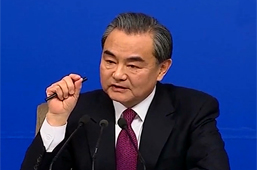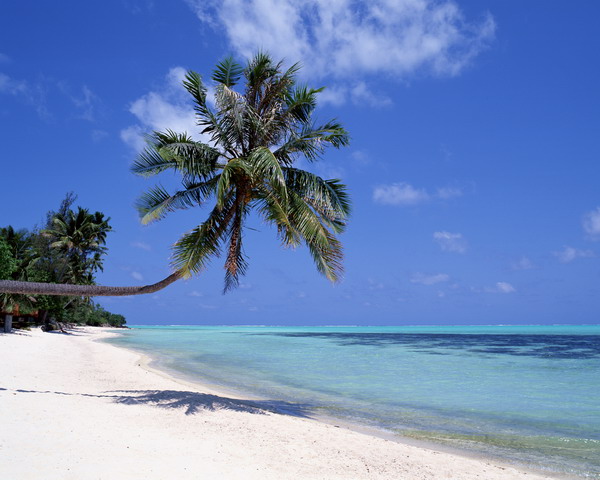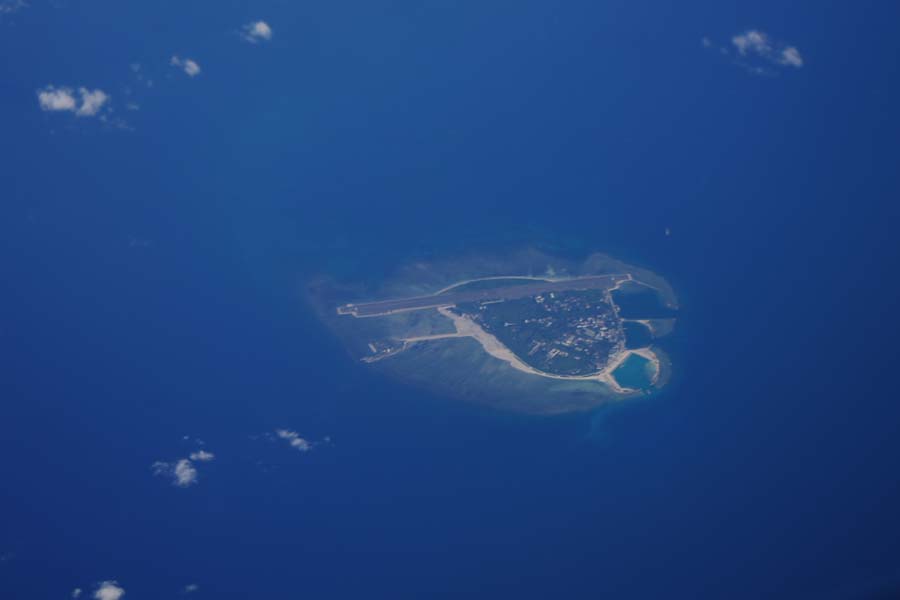1990
From January 22 to 25, the Department of Research and Development of the Ministry of Foreign Affairs, Indonesia, convened the first informal seminar on "the potential conflicts on the South China Sea" as a convener.
On December 13, while talking about the Nansha issues during his visit to Malaysia, Premier Li Peng pointed out that "the Nansha Qundao is China's territory. This is an indisputable fact."
1991
In April, the construction for the airport on the Yongxing Dao of Xisha Qundao was completed.
On May 11, the monument for the construction projects on Nanhai Zhudao of China was established on the Yongxing Dao. The front side of the monument was engraved with the inscription as follow: "Nanhai Zhudao has witnessed the vicissitudes of history for thousands of years, and the descendants of Yan and Yellow Emperors are embarking on a new cause today". It had recorded the indisputable fact that Nanhai Zhudao had always been parts of China's territory, and had given an account of the great achievements of building the oceanographic station on the Yongshu Jiao and other projects on Nanhai Zhudao accomplished by the Chinese military and civilian people together. And the back of the monument was inlaid with a general map of Nanhai Zhudao made of colored porcelain tiles.
From May 29 to June 17, Hainan Province carried out a comprehensive survey on the resources on the Xisha Qundao for the first time.
On June 6, archaeologist Wang Hengjie found some reddish brown coarse pottery shards, pottery net weights and zax dated to the Neolithic Age and some debris of stamped pottery wares dated to the Qin and Han Dynasties. This was the first time to discover relics dated to the Neolithic and the Han Dynasty.
On June 7, 1991, in an interview with some journalists from Indonesia, Chinese President Yang Shangkun said, "China has indisputable sovereignty over Xisha Qundao, Nansha Qundao as well as their adjacent waters. It is China's consistent position to solve the international disputes by peaceful means, and we propose joint-development which is in line with the interests of all parties concerned."
1992
On January 15, "the visiting and inspecting delegation of Hainan Provincial People's Government to Nansha Qundao" held a ceremony on the Zengmu Ansha, placing 7 sovereignty monuments engraved with "Hainan Provincial People's Government, January 1992" to the reef plates of the Zengmu Ansha.
On February 5, the Philippine Ambassador to Germany Bienvenido A. Tan, Jr. stated in a letter to German HAM radio amateur Dieter that Huangyan Dao does not fall within the territorial sovereignty of the Philippines.
On February 25, the Law of the People's Republic of China on the Territorial Sea and the Contiguous Zone was officially published and implemented. The 2nd article of this law provides that, "the land territory of the People's Republic of China includes the mainland of the People's Republic of China and its coastal islands; Taiwan and all islands appertaining thereto including Diaoyu Islands; Penghu Islands; Dongsha Qundao; Xisha Qundao; Zhongsha Qundao and Nansha Qundao; as well as all the other islands belonging to the People's Republic of China".
On May 8, China National Offshore Oil Corporation (CNOOC) and the US Crestone Energy Corporation signed in Beijing a contract on joint exploration and exploitation of petroleum within the about 25,255 square kilometers scope of the "North Wan-An No. 21 Contract Zone" on the western sea area of Nansha Qundao. This contract was approved by the Chinese government on May 22, and came into effect on June 1.
On June 5, Malaysia and Vietnam signed in Kuala Lumpur a Memorandum of Understanding for the Exploration and Exploitation of Petroleum in a Defined Area of the Continental Shelf Involving the Two Countries", reaching a temporary arrangement for carrying out underwater exploration and exploitation of petroleum in the so-called overlapped zone for both sides.
On July 16, in reply to a journalist's question about the tense situation in the region of the Nansha Qundao, the spokesperson of the Ministry of Foreign Affairs of China said, "Nansha Qundao has always been parts of China's territory. In order to maintain the peace and stability of this region, we have over and over again made it clear that we are willing to resolve the disputes through negotiation with all parties concerned, and put forward the proposal of shelving differences and seeking joint development". We "oppose to internationalize the issue."
On July 22, China became a "consultation partner" of the ASEAN. The 25 ASEAN Foreign Ministers Meeting passed the ASEAN Declaration on the South China Sea, calling for all parties concerned to "exercise restraint" and to resolve the disputes pertaining to the South China Sea "by peaceful means, without resorting to force".
1993
On April 19, Secretary General of the Chinese Communist Party, State President and Chairman of the Central Military Commission, Jiang Zemin inspected the Yongxing Dao of Xisha Qundao.
1994
In April, in order to execute the contract with CNOOC which was signed in May 1992, the US Crestone Energy Corporation rented the Chinese Survey Ship "Experiment No. 2" and entered the "North Wan-An No. 21 Contract Zone" for seismic survey and oil & gas exploration. Vietnam sent armed vessels to desperately stand in its way. In order to avoid the escalation of the conflicts, the Chinese survey ship had to sail back without performing its job.
From May 27 to June 7, Vietnam took the liberty to build two light towers on the Riji Jiao and the West Jiao of Nansha Qundao without China's permission.
On June 16, the spokesperson of the Ministry of Foreign Affairs of China made a statement on Vietnam's sending vessels to enter the area of the Wan-An Bank of China's Nansha Qundao for geophysical exploration, pointing out that China has indisputable sovereignty over the Nansha Islands as well as the adjacent sea area. And the Wan-An Bank is part of Nansha Qundao.
On June 25, the 8-person Expedition Team of China Radio Amateur headed by Chen Ping landed on Huangyan Dao.
On July 7, the spokesperson of the Ministry of Foreign Affairs of China made a statement on the Resolution on the Ratification of the UN Convention of the Law of the Sea (1982) passed by the National Assembly of Vietnam on June 23, reaffirming China's position on the issue of Xisha Qundao and Nansha Qundao and pointing out that in the Resolution, "the Vietnamese side once again laid sovereignty claims over China's Xisha Qundao and Nansha Qundao. China's position on this issue is consistent and explicit. China has indisputable sovereignty over Xisha Qundao, Nansha Qundao as well as the adjacent sea area. The Chinese government absolutely cannot accept the above-mentioned sovereignty claims laid by the Vietnamese side."
From November 19 to 22, the Chinese President Jiang Zemin paid an official visit to Vietnam. The two states published a communiqué clarifying that China and Vietnam shared common positions on the issue of peaceful solution of maritime conflicts. And for the long term resolution of the Issue of Nansha Qundao, both sides agreed to set up a maritime expert group to carry out dialogues and consultations.
1995
China constructed fishing shelter facilities on the Meiji Jiao of Nansha Qundao, which was garrisoned by the Administration of Fishery and Fishing Harbor Supervision of the South China Sea Area under the Ministry of Agriculture.
On May 10, the State Department of the US made a policy statement on Nansha Qundao and the South China Sea Issue, expressing that the US would not air its opinion about the legal basis of the sovereignty disputes over the South China Sea. Yet it also stressed that maintaining the freedom of navigation and allowing all ships and airplanes to sail on/fly over the South China Sea without hindrance concerned the fundamental interests of the US. The US urged all parties concerned to stay restrained, and avoid taking actions that would damage stability.
On May 13, the Philippine Military schemed and organized a formation consist of two warships and a tourist ship carrying both Philippine and foreign journalists to sail to the Meiji Jiao of China's Nansha Qundao for "news gathering". Before, the Ministry of Foreign Affairs of China had already lodged solemn representations to the Philippine side for many times, requesting the Philippine side to cancel this act of provocation. However, the Philippine side still went its own way. So the Chinese government lodged a strong protest to the Philippine government with regard to this.
On June 14, the President of the Philippines Ramos confirmed that the National Administration of Surveying, Mapping and Information Resources of the Philippines had begun to carry out prospecting, surveying and mapping activities on Nansha Qundao. Besides, the Philippine government would allocate 178.8 million pesos to construct 3 light houses on Nansha Qundao. These light houses, after being completed, would be used as the legal basis for the determination of new baseline.
1996
In April, Vietnam and Continental Oil Corporation, a subsidiary of the US DuPont Company, signed an oil-exploration and exploitation contract which covered an area of about 12,000 square kilometers. And its location covered the "North Wan-An No. 21 Contract Zone".
On May 15, the Chinese government published the Statement of the People's Republic of China on the Baseline of the Territorial Sea of the People's Republic of China, declaring parts of the baseline of the territorial sea of Chinese Mainland and the baseline of the territorial sea of Xisha Qundao. And it was made clear in the statement that the remaining baseline of the territorial sea will be further declared.
On May 15, the 8th National People's Congress made the decision on the Ratification of the UN Convention of the Law of the Sea. This decision at the meantime made a statement of four points including the reiteration of China's sovereignty over the archipelago and islands as described in the Law of the People's Republic of China on the Territorial Sea and the Contiguous Zone enacted on February 25, 1992.
1997
On May 20, the No. 62098 Fishing Boat of Taishan, Guangdong, together with 21 fishermen was illegally seized by the No. 70 Warship of the Philippine Navy during their fishing activity around the waters around Huangyan Dao. The Chinese government lodged strong protest against the Philippines' unreasonable conduct of seizing the Chinese fishermen, and requested for the release of all fishermen immediately.
In July, Eliodoro Ubiyatas, Judge of the Court of Olongapo City of the Philippines rejected the Philippine government's accusation of 21 Chinese fishermen's illegal intrusion into the sea area of the Philippines. Ubiyatas said he made the verdict according to a martial law promulgated by the former president Marcos in the 1970s, which defined the boundaries of the Philippines and clarified that the issue of the area with sovereign disputes in the 200 nautical-mile exclusive economic zone shall be solved through a resolution passed by all parties concerned. He said, for there is no treaty determining the sovereignty of Huangyan Dao signed between China and the Philippines, "I think the accusation of illegal intrusion is insufficient."
In December, on the informal summit of ASEAN, China, Korea and Japan, China and the ASEAN member states published a joint statement indicating that with regard to the issue of the sovereignty of Nanhai Zhudao, all parties concerned promised to seek peaceful resolution of disputes without resorting to the threat of force or use of force.
1998
China constructed four 3-story buildings of reinforced concrete structure on the Meiji Jiao, making this reef a permanent outpost of the People's Republic of China.
1999
On March 5, the Ministry of Agriculture of China issued the Notice on the Implementation of New System for Summer Moratorium of Marine Fishing on the Sea Area of the South China Sea. It decided that starting from the year of 1999, every year from zero o'clock of June 1 to the 24 o'clock of July 31, the new system for summer moratorium will be implemented, all trawling (including trawling of shrimps or shellfishes), purse seining and beam trawling operations on the sea area of the South China Sea (including the Beibu Bay) north of 12°N shall be forbidden. This was the first time for China to implement summer moratorium of marine fishing on the South China Sea.
In March, the Philippines publicly declared that it will carry out the extension of airport runway on Zhongye Dao, and build up military installations. The Ministry of Foreign Affairs of China lodged strong protest against it.
In March, the first China-Philippines Experts Group Meeting on Confidence-Building Measure on the South China Sea was held in Manila, capital city of the Philippines. Both sides promised to solve the disputes through friendly consultation according to the principles of international law, rather than resort to the use of force of the threat of force.
On May 9, a beat-up tank landing ship of the Philippines Navy sailed for the Ren'ai Jiao of Nansha Qundao. Claiming a leakage on the hull bottom, it "graveled" on the northwestern reef flat of the Ren'ai Jiao. Later, the Chinese side had been lodging representations to the Philippine side and requesting the Philippine side to tow away the ship as soon as possible. Yet taking "lack of parts" for excuses, the Philippine side did not tow the ship away, attempting to strengthen the illegal existence and illegally invade and occupy the Ren'ai Jiao.
In mid May, Malaysia invaded China's Investigator Shoal and Boji Jiao.
On May 18, China officially presented a diplomatic note to Malaysia, requesting the later to "right the error" and stop "invading" China's territorial sovereignty over Nansha Qundao and adjacent waters.
On November 3, taking "seawater flooding engine room" for excuses, a tank landing ship of the Philippines graveled on the northwestern side of the ingress of the lagoon of Huangyan Dao, attempting to invade and occupy Huangyan Dao by this means. After repeated representations made by the Chinese side, the Philippines towed the graveled warship away on November 29.















